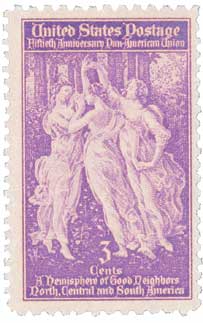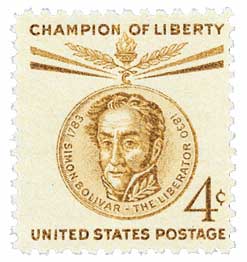
# 895 - 1940 3c Pan-American Union
3¢ Pan-American Union
City: Washington, D.C.
Quantity: 47,700,000
Printed by: Bureau of Engraving and Printing
Printing Method: Rotary Press
Perforations: 10.5 x 11
Color: Light violet
Founding Of The Pan American Union

On April 14, 1890, the United States and several Latin American countries created the Pan American Union to address matters of common interest.
One of America’s earliest attempts to promote cooperation between nations in the Western Hemisphere was the passage of the Monroe Doctrine in 1823. That document prevented European nations from colonizing any countries in the Western Hemisphere. In spite of this, Spanish-American leaders did not completely trust the United States.

Three years later, Simón Bolívar suggested an international organization in the Americas while attending the 1826 Congress of Panama. As he Bolivar saw it, such an organization could include a mutual military and defense pact and parliamentary assembly. Representatives from Gran Colombia (modern-day Colombia, Ecuador, Panama, and Venezuela), Peru, Bolivia, the United Provinces of Central America, and Mexico attended his proposed meeting. But only Gran Colombia ratified the “Treaty of Union, League, and Perpetual Confederation” that was set forth.
Major changes came in the next few years – Gran Colombia was embroiled in Civil War, the United Provinces of Central America was dissolved, and many began to focus more on their own nations than the New World as a whole.
3¢ Pan-American Union
City: Washington, D.C.
Quantity: 47,700,000
Printed by: Bureau of Engraving and Printing
Printing Method: Rotary Press
Perforations: 10.5 x 11
Color: Light violet
Founding Of The Pan American Union

On April 14, 1890, the United States and several Latin American countries created the Pan American Union to address matters of common interest.
One of America’s earliest attempts to promote cooperation between nations in the Western Hemisphere was the passage of the Monroe Doctrine in 1823. That document prevented European nations from colonizing any countries in the Western Hemisphere. In spite of this, Spanish-American leaders did not completely trust the United States.

Three years later, Simón Bolívar suggested an international organization in the Americas while attending the 1826 Congress of Panama. As he Bolivar saw it, such an organization could include a mutual military and defense pact and parliamentary assembly. Representatives from Gran Colombia (modern-day Colombia, Ecuador, Panama, and Venezuela), Peru, Bolivia, the United Provinces of Central America, and Mexico attended his proposed meeting. But only Gran Colombia ratified the “Treaty of Union, League, and Perpetual Confederation” that was set forth.
Major changes came in the next few years – Gran Colombia was embroiled in Civil War, the United Provinces of Central America was dissolved, and many began to focus more on their own nations than the New World as a whole.








